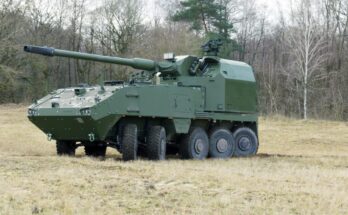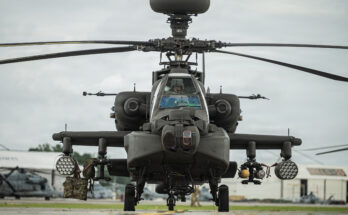The U.S. Army is seeking $182.3 billion in its FY20 budget request, up from $179 billion enacted by Congress in FY19. Compared to the FY19 enacted level, the service wants $2.7 billion more for operation and maintenance, $1.2 billion more for research and development, and $882 million more for personnel, while procurement stands to drop by $1.7 billion.
The service’s procurement account totals $25.2 billion in the FY20 request. The $2.6 billion ammunition account is the only coffer to see an increase over FY19 (+$268 million), while aircraft (-$569 million), missiles (-$512 million), weapons and vehicles (-$527 million), and other procurement (-$799 million) accounts are all subject to modest declines from enacted levels.
Despite the drop in spending from the previous year, the Army is actually receiving more procurement dollars than originally planned for FY20, including increases of $1.4 billion for missiles, $630 million for aircraft, $841 million for weapons and vehicles, $745 million for ammunition, and $852 million for other procurement. It should be noted that these figures include Overseas Contingency Operations funding, skewing the calculations because the Pentagon typically does not forecast OCO beyond the current fiscal year.
The new budget also bolsters outyear procurement compared to estimates from the FY19 budget, outlining an additional $3.2 billion for procurement in FY21, $1 billion in FY22, and $963 million in FY23. Budget projections are not set in stone and are likely to change, but they do provide a glimpse of how priorities have shifted in any given year. The largest increases beyond FY20 are for missiles and the Other Procurement account, which pays for electronics, tactical wheeled vehicles, and other miscellaneous programs.
The Army was not left out of the Pentagon’s broader efforts to bolster advanced weapons development, and the service’s $12.4 billion research, development, test and evaluation request is $1 billion more than enacted in FY19. More significantly, the FY20 research budget is $3 billion higher than originally planned for FY20, reversing a planned cut to $9.4 billion.
The FY20 request begins a multiyear process outlined by the Army to boost funding for its top six modernization priorities by scaling back or canceling lower priority efforts. Service officials have identified around $31 billion worth of funding adjustments over multiple years to support long-range precision fires, future vertical lift, next-generation combat vehicles, air and missile defense, communications networks, and soldier lethality. The bulk of the funding changes are backloaded, meaning they will come toward the end of the latest five-year spending plan period. Nevertheless, the initial impact can already be seen in the FY20 request.
A number of vehicle programs were scaled back in the new budget. The Army is buying 2,530 Joint Light Tactical Vehicles, which is 505 fewer than planned. Service officials said they have no shortage of tactical vehicles at the moment, so cutting the procurement rate will not hinder operations. Overall, the Army is reducing JLTV procurement by 852 vehicles between FY20 and FY23 compared to the previous year’s plan. The bulk of the cuts are in FY20 and FY22. For now, however, the overall procurement target for JLTVs has not changed.
The Army’s investment in Bradley upgrades in FY20 is on track with previous estimates, but funding has been scaled back by $890 million between FY20 and FY23. The Army will buy an additional five brigade sets of upgraded A4 vehicles before winding down the program in 2023 to make way for the Next Generation Combat Vehicle. Prior to the release of the FY20 budget request, the Army had already terminated its planned Bradley A5 lethality upgrade in order to free up funding for the NGCV.
Even the new Armored Multi-Purpose Combat Vehicle takes a hit, though not until FY21. The Army requested funding for 131 vehicles in FY20, one more than planned, but the budget cuts 61 vehicles from the FY21 buy. Funding for HEMTT heavy trucks was also reduced in the FY20 request.
Not all vehicle programs suffered, however. The Army wants to upgrade 165 Abrams tanks to the M1A2 System Enhancement Package (SEP) v3 configuration, which is 73 more than planned. The service also wants to upgrade 152 Strykers, and procure 53 M109A7 Paladins, 16 M88A2 recovery vehicles, and 44 Joint Assault Bridge platforms.
The FY20 request includes $378.4 million for system development and demonstration of the Optionally Manned Fighting Vehicle, part of the NGCV family. A total of $1 billion is programmed for this effort through FY24. The budget also includes $219 million in FY20 for NGCV applied research and $160 million for advanced technology development, with a total of $2.1 billion set aside for the program through FY24. The service also wants $310.2 million for development of the Mobile Protected Firepower light tank.
The Army has outlined plans to invest billions of dollars in the Future Vertical Lift program. The service requested $718.1 million in FY20, and plans to spend some $4.9 billion over the next five years. Within the FVL family, the Future Attack Reconnaissance Aircraft (FARA) accounts for $427.3 million in FY20 and $2.1 billion through FY24. FARA is the planned replacement for the interim Apache helicopters serving in the armed scout helicopter role since the OH-58 Kiowa fleet was retired in 2017.
The FVL investment has resulted in cuts elsewhere in the Army’s aviation budget. The biggest cutback is the cancellation of the planned CH-47F Block II upgrade. The Block II improvements were geared toward addressing capability issues the Army faced at high altitudes and in hot environments, like Afghanistan, and toward increasing the capacity to carry the heavier JLTV. Those priorities were driven by past wars, and the military has since shifted its focus to potential conflicts with China and Russia, where operating requirements would be quite different. That is not to say a high-hot requirement will not resurface at some point down the road. For now, however, the Army will, at minimum, still proceed with Block II upgrades of 69 MH-47G variants for Special Operations.
The budget request includes 73 Black Hawk helicopters (58 UH-60Ms and 15 HH-60Ms), which is 25 more than planned. However, 24 aircraft are removed between FY21 and FY23. The Army wants 48 upgraded AH-64E (Block III) Apaches as planned, but five new-build Apaches planned in each of FY20 and FY21 have been removed. The budget also includes six MQ-1 Gray Eagle unmanned aerial vehicles.
Missiles had a strong showing in the budget request, which comes as no surprise. The Pentagon is not only refilling stocks of weapons like HELLFIRE missiles expended during combat operations, but also bolstering its missile capabilities for future conflicts. The budget includes 147 Patriot MSE missiles (54 more than planned), 5,112 HELLFIRE missiles (+3,664), 697 Javelin missiles (+147), 1,460 TOW missiles (+536), and 9,570 Guided Multiple Launch Rocket System (GMLRS) rockets (+4,470).
Outyear procurement for HELLFIRE has also been increased significantly. The Army is planning to buy a further 7,672 missiles between FY21 and FY23, an increase of 5,110 missiles compared to the previous spending plan. However, the Army has scaled back procurement of the Joint Air-to-Ground Missile (JAGM), a follow-on to the HELLFIRE. The service envisioned buying 1,108 JAGMs in FY20 and a total of 5,695 missiles between FY20 and FY23. The FY20 request includes 609 missiles, with 2,232 missiles planned through FY23, a reduction of 3,464 units.
The budget also contains funding for 240 Army Tactical Missiles and $262.1 million for 44 mobile short-range air defense (M-SHORAD) systems. The M-SHORAD effort involves outfitting wheeled Stryker vehicles with anti-aircraft guns and missiles. The start of M-SHORAD procurement has resulted in a funding reduction for HMMWV-based Avenger air defense systems.
The budget includes a new-start hypersonic weapons development program for the Army, with $228 million requested in FY20 and a total of $1.2 billion programmed through FY24. This effort supports Long-Range Hypersonic Weapon prototyping, with a system flight test planned in 2023. The service has also allocated $412.9 million for long-range precision fires development, with $1.8 billion set aside over the next five years. This investment includes $164.2 million in FY20 and $848.7 million over five years for continued development of the Precision Strike Missile (PrSM), which will replace the Army Tactical Missile System.
Shaun's deep-rooted interest in military equipment continues in his role as a senior defense analyst with a focus on the United States. He played an integral role in the development of Forecast International's U.S. Defense Budget Forecast, an interactive online product that tracks Pentagon acquisition programs throughout the congressional budget process. As editor of International Military Markets – North America, Shaun has cultivated a deep understanding of the vast defense markets in the United States and Canada. He is a regular contributor to Forecast International's Defense & Security Monitor blog and has co-authored white papers on global defense spending and various military programs.




